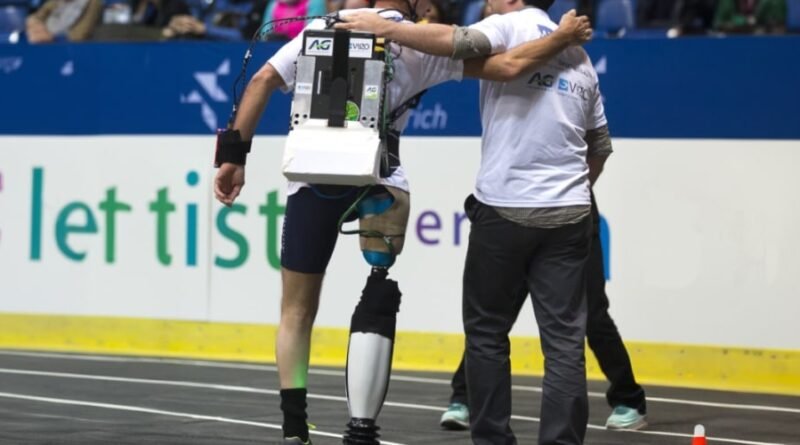VUB’s Dr. Flynn Discusses Robotic Prosthetics
With around 3.18 million people living in the European Union with lower limb amputations, and approximately 295,000 new amputations performed each year, projects that help people move more easily and effectively are of paramount importance. The loss of a lower limb significantly affects quality of life, independence, and daily activities, making the development of effective prosthetic solutions a priority in the field of medical technology.
Today, robotics is one of the areas providing innovative solutions in this domain. Advanced robotic systems can replace the functions of lost limbs, provide additional strength for movement, and enable more natural and safer walking. One such project was CYBERLEGs, which focused on developing active transfemoral (above-the-knee) lower limb prostheses. The project combined sophisticated mechanical design, advanced electronics, and artificial intelligence algorithms to give amputees greater mobility and independence in their daily activities.
Building things that could directly help individuals is a wonderful thing to be able to do
Dr. Ir. Louis Flynn is a postdoctoral researcher at the Faculty of Engineering, Vrije Universiteit Brussel, Department of Mechanical Engineering. He earned his Bachelor’s degree in Mechanical Engineering from the University of Southern California in 2002, followed by a Master’s degree from Michigan State University in 2009.
His research career has been dedicated to the development of advanced prosthetic systems, particularly through the international CYBERLEGs project, which focuses on the design, instrumentation, and control of active transfemoral lower-limb prostheses.
Dr. Flynn is the author and co-author of numerous scientific publications in the fields of biomechatronics and rehabilitation robotics, presented at prestigious conferences such as IEEE RAS/EMBS BioRob, ICORR, and Neurotechnix. His work makes a significant contribution to the development of innovative solutions that enhance mobility and improve the quality of life for individuals with amputations.
“I love that these are hard problems that, if solved, have the potential to help a lot of people. Building things that could directly help individuals is a wonderful thing to be able to do,” said Dr. Flynn.
In 2016, Vrije Universiteit Brussel (VUB) participated for the first time in the CYBATHLON in Zurich, Switzerland, presenting the CYBERLEGs Beta-Prosthesis with a newly developed control system. The prosthesis, featuring two active degrees of freedom at the knee and ankle, assisted the user in everyday functional tasks such as sitting and standing from a chair, stair climbing, slope walking, and obstacle avoidance. Importantly, the VUB pilot could complete tasks that were not possible with his personal prosthesis, showcasing the potential of active powered prostheses.
Last year, for the second time, a team from Vrije Universiteit Brussel participated in the CYBATHLON 2024 with their advanced robotic leg prosthesis, the CYBERLEGs X-Leg. Their participation was part of the project “AI-driven wearable robotics for healthcare, (AidWear), coordinated by the VUB Robotics and Multibody Dynamics (R&MM) group with contributions from KU Leuven’s Department of Electrical Engineering and the Multibody and Mechatronic Systems Laboratory at ULiège. As project coordinator, Tom Verstraten explained, “A robotic prosthesis is extremely complex. To make it move naturally and intuitively, like a biological leg, we applied AI and machine learning. Bringing this technology outside of the lab was a major challenge.”
In other words, the team worked not only on the mechanical design of the prosthesis but also on advanced software to make it respond smoothly and predictably to the user’s movements. Almost a year ago, the Vrije Universiteit Brussel sent its CYBATHLON athlete, Michel Jacques, to the international CYBATHLON 2024 competition in Zurich with an advanced robotic prosthesis. Michel Jacques is an above-knee leg amputee who tests and uses robotic prostheses, and his experience helps the team to test the functionality of the device in real conditions. The prosthesis stems from the European project CYBERLEGs++. Michel Jacques emphasized the advancement of technology: “I got my first prosthesis 25 years ago, and it was made of wood and leather. It’s incredible to see what’s possible today and to be a part of it.”
The development and future of robotic prosthetics
When it comes to the development of the CYBERLEGs project, what were the key moments for you?
Dr. Flynn: Key moments were every prototype we built, as soon as you get it on a person and have people use it, you see exactly where issues are that you didn’t think about previously, and where things could be done better. Having people using your devices is always a great feeling when it works as planned. When they break or have problems, you want to build new devices to address those issues.
To what extent are the accessibility—both financial and technical—of modern robotic prosthetics an obstacle to their wider use in everyday clinical practice?
Dr. Flynn: This is a huge issue, particularly in getting insurance to fund robotic therapies that we know do have some impact, such as gait training systems and arm-based robotic therapies. They are expensive devices to install and expensive to run; they take some time to set up, which takes time away from treatment because of the way billing is handled. So, there are many issues, but I am not on the clinical side and don’t deal with patient billing, so I only know what I hear from people trying to make these technologies more available to the general public.
The technical issues we have deal with the way the devices work with the person. Active devices are not intuitive and reliable enough at this point to provide support all the time. The control is not good enough to reliably understand what the user is doing, which can lead to undesired responses. Current active devices are also heavy, extremely expensive, and much more complicated compared to reliable passive devices.
How well do the existing legal frameworks and medical laws regulate safety, liability, and data privacy in the use of prosthetics with a built-in artificial intelligence algorithm? Is there a need for new legal classifications of medical devices when they include ‘cognitive’ components, and how does this affect the legal status of the patient as a user of such a system?
Dr. Flynn: This is an important question in the broader sense, as to what personal data from any system is used for AI, what is considered personal data, how we should protect data that should be protected, and how to keep data that is collected private. I think it is difficult to say. Currently, AI requires a lot of personal data to work, and the balance of getting that data while respecting the privacy of individuals is not yet decided. I am sure the current framework will need to be adjusted as the technology improves and the benefits and repercussions of the technology are better understood.
What changes or additional support would be helpful for you in the development of robotic prosthetics?
Dr. Flynn: In the past, there were many calls for prosthetic development in the EC, but that has fallen in recent years. We need funding for these projects to continue, and Europe is set for these innovations to happen. One issue we have been running into is that it is difficult to find some of the manufacturing capabilities within Europe for our parts and materials, and I hope that through these projects, we can improve the relationships with manufacturing within Europe.. There should be better ways for our groups to find European suppliers and European-sourced production for small projects.
How much electrical energy is required for the development of these and similar prosthetics, how much they consume, and, for example, how important energy efficiency is, and whether it is difficult to balance all of these factors?
Dr. Flynn: Energy efficiency and utilizing energy in a way that delivers that energy to the person are the main problems of these devices. The battery weight is significant not only for weight, but for the size of the device, and really, any weight removed is helpful. The only reason we are talking about powered prostheses today is that battery and motor technology are on the edge of being light and strong enough to provide clinically useful power to people if used intelligently.
Current AI models consume a considerable amount of energy to train, but the actual implementation of the models can be done relatively efficiently. One of the goals of AidWear is to be able to help reduce the complexity of these models to be able to efficiently run on smaller computers.
How important it is for cities to be sufficiently adapted for these devices, and what changes in the urban environment would make life easier for users
Dr. Flynn: Ideally, the city won’t have to change for robotic prostheses if they work as well or better than an average limb. The issue is that we aren’t there yet. There are many problems with the way the prosthesis connects to the body, power and weight issues, durability issues, control issues, etc., so many that the devices that are on the market today aren’t used as much as the potential for powered devices promises.
3.18 Million EU Amputees, European Market to Reach $810M by 2030
In May 2025, the Vrije Universiteit Brussel (VUB) organized a seminar dedicated to sustainable robotics and advanced technologies for assisting people with disabilities, with a special emphasis on the development of robotic prostheses and exoskeletons. The seminar brought together experts from the Brubotics laboratory. Dr. Louis Flynn’s presentation was titled “Assistive Technologies for the Lower Extremities – Prostheses and Exoskeletons.”
Taking into account that in the European Union there are an estimated 3.18 million people with lower limb amputations, and approximately 295,000 new amputations are performed each year, the development of projects that facilitate mobility and improve the quality of life for these individuals is extremely important. Accordingly, the market for robotic prostheses in Europe is experiencing significant growth. Current projections indicate that the European robotic prosthetics market could reach a revenue of approximately US$810.5 million by 2030. Projects such as CYBERLEGs and the CYBATHLON competitions represent key initiatives that not only advance technological development but also promote broader societal awareness of the needs of people with amputations. Continued investment in research and development, along with strong support for innovation, is essential to drive further progress in this field.
Image: VUB team during the 2016 edition of CYBATHLON © Louis Flynn
Acknowledgments: They thank the EC for funding CYBERLEGs (FP7) and CYBERLEGs++ (FP8), FOD BOSA of Belgium for supporting AidWear, and FWO for supporting the Revalexo exoskeleton project, which addresses many of the same challenges as AidWear.
These publications were produced as part of the Maria Leptin EMBO Fellowship, which allowed us to spend two months exploring the world of science at VUB in Brussels. Importantly, all articles were the result of our own choice of topics and in accordance with our interests.


